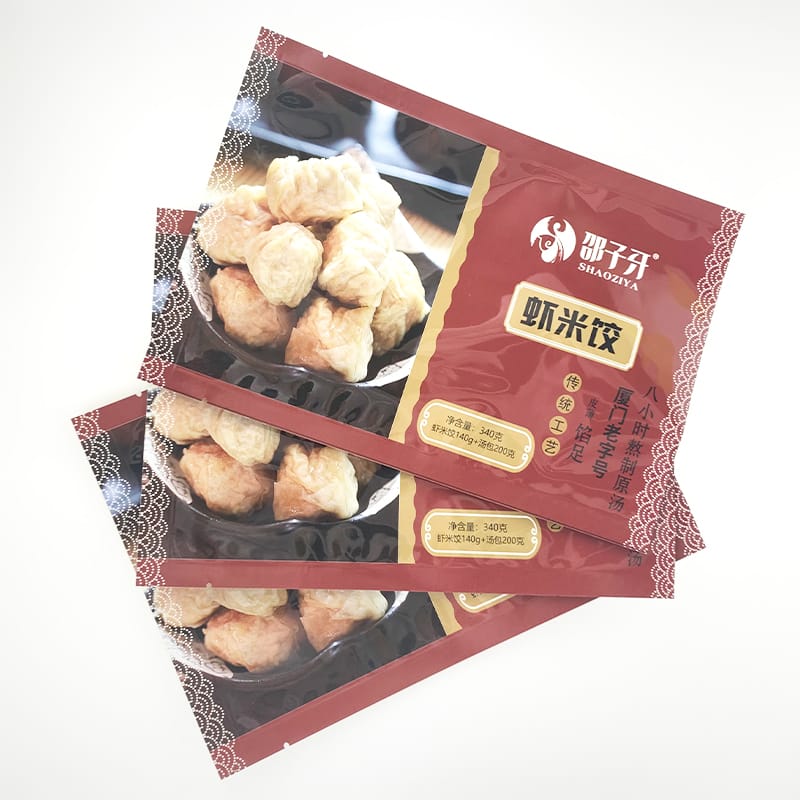The main categories of frozen food:
With the improvement of living standards and the accelerated pace of life, reducing kitchen labor has become people’s needs, and frozen food is favored by people for its convenience, fastness, delicious taste and rich variety. There are four main categories of frozen food:
1. Aquatic quick-frozen foods, such as fish and shrimp, crab sticks, etc.
2. Frozen fruits and vegetables, such as bamboo shoots, edamame, etc.
3. Livestock quick-frozen food, such as pork, chicken, etc.
4. Conditioning quick-frozen foods, such as pasta dumplings, dumplings, steamed buns, hot pot fish dumplings, fish balls, tribute balls, fried chicken nuggets, squid steaks, and dishes, etc.
packaging bag
For so many types of frozen food, the safety and benefits of frozen food depend on four main aspects:
First, the raw materials of the processed food are fresh and of good quality;
Second, the processing process is pollution-free;
The third is to pack well, not to break the bag to pollute;
The fourth is the whole cold chain.
Packaging is an important part of frozen food, related to food safety, corporate reputation and profitability.
Frozen food packaging should pay attention to considerations:
1. Packaging standards and regulations.
Second, the characteristics of frozen food and its protection conditions.
3. Performance and scope of application of packaging materials.
4. Food market positioning and regional conditions of circulation.
5. The influence of the overall structure and material of packaging on frozen food.
6. Reasonable packaging structure design and decoration design.
Seven, packaging testing.
The packaging of frozen food must meet the requirements of large circulation, from production, transportation to sales, to maintain the quality characteristics of frozen products, and prevent the pollution of bacteria and harmful substances. Taking quick-frozen dumplings as an example, many consumers resisted buying some brands after one-time consumption. Many of the reasons are that the packaging materials are not good, causing the dumplings to lose water, oxidize oil and air-dry, turn yellow, crack, crusty, etc. Odor and other quality problems.
Frozen food packaging should have five characteristics:
1. It must have high barrier properties to prevent the product from contacting with oxygen and volatilizing water.
2. Impact resistance and puncture resistance.
3. Low temperature resistance, the packaging material will not deform or crack even at a low temperature of -45 °C.
Fourth, oil resistance.
5. Hygiene, preventing the migration and penetration of toxic and harmful substances into food.
Plastic flexible packaging used in the field of frozen food is mainly divided into two categories:
One is composite packaging, in which two layers of plastic films are bonded together with an adhesive, and most of the adhesives contain harmful substances such as esters and benzene, which can easily penetrate into food and cause pollution.
One is advanced multi-layer co-extruded high-barrier packaging. It is produced with green and environmentally friendly packaging materials, with five layers, seven layers, and nine layers. Instead of using adhesives, more than 3 extruders are used to combine resin raw materials with different functions such as PA, PE, PP, PET, EVOH It has the characteristics of no pollution, high barrier, high strength, flexible structure, etc. It makes the production process of food packaging and packaging materials pollution-free. For example, the seven-layer co-extruded high-barrier packaging is composed of more than two layers of nylon, which greatly improves the tensile and tear strength of the packaging. High and low temperature resistance, storage and transportation resistance, easy storage, can effectively avoid food oxidative deterioration and water loss, inhibit microbial reproduction, thereby extending the shelf life of frozen food.
Post time: Aug-29-2022


